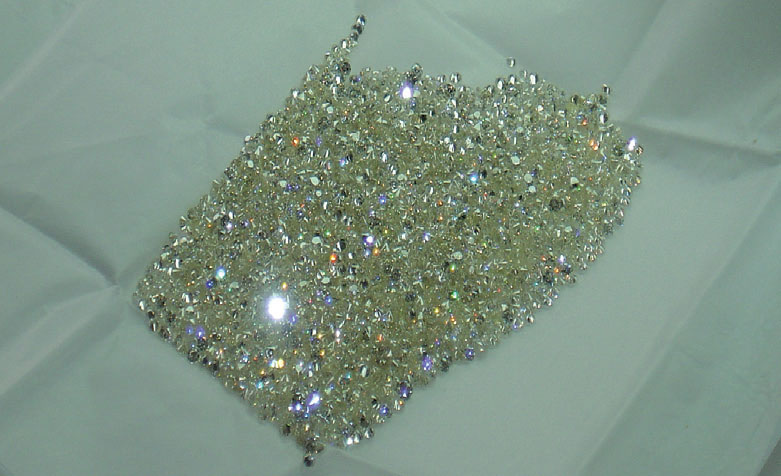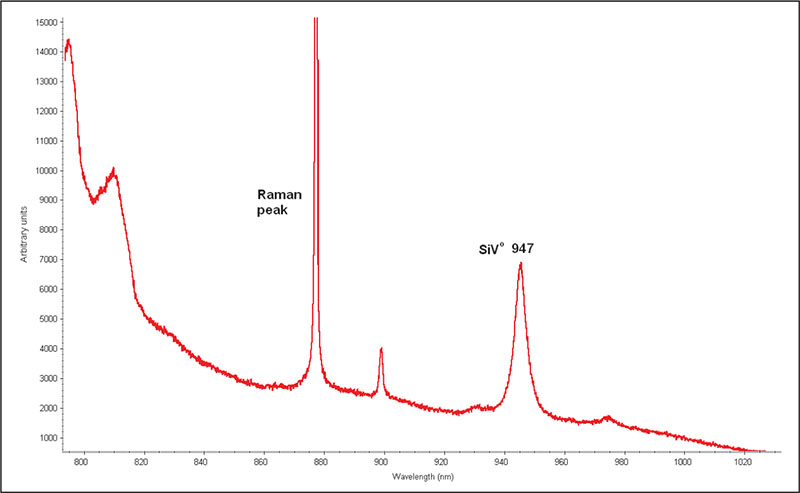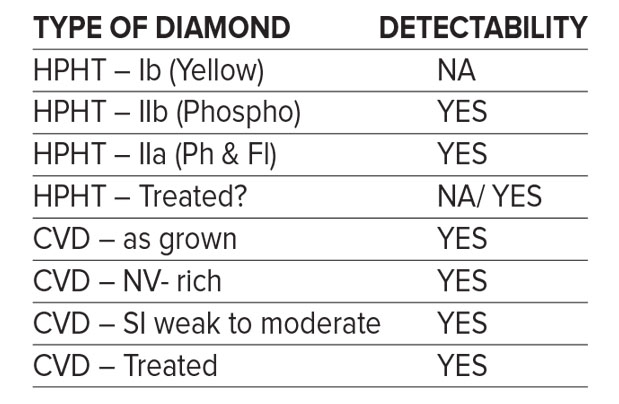During the recent past, there has been tremendous progress in laboratory-grown diamonds, ranging from nano diamonds to large single crystals of gemmological interest. The diamond synthesis is done by two routes; one is by high pressure high temperature (HPHT) method and the other using Chemical Vapour Deposition (CVD). A major breakthrough, which has relevance to gemstone industry, is the large-scale production of colourless diamonds by HPHT and CVD routes in sizes ranging from half a cent to a few carats. This article deals with the distinct spectroscopic features observed in synthetic diamonds and their use as diagnostic methods for the detection of synthetic diamonds. Further, it gives an account of development of the luminescence-based method in our laboratory to detect and isolate synthetic diamonds in large diamond batches (or packets) of natural diamonds in star-melee sizes.
The diamonds grown via HPHT route are predominantly of type Ib, and more recent ones are of type IIb (few cases of type IIa are also reported); all CVD diamonds are known to be of type IIa. Currently, the most challenging aspect is the detection of synthetic diamonds mixed in the natural diamond supply chain; this is of special relevance to the Indian gem grade diamond industry.
Diamond, made up of sp3 hybridised carbon atoms, has remarkable optical, thermal and electronic properties. Its gemmological applications are well known. It is a colourless solid when free of point defects and chemical impurities. However diamond can be obtained in many attractive colours due to plastic deformation and interplay of nitrogen impurity and carbon vacancies. Diamond can be formed in nature only under high pressure and high temperatures that exist deep inside the earth; typical pressure and temperatures being in the range of 10 GPa and 2500°C respectively. Carbon would exist as graphite at lower pressures and temperatures. The triple point at which graphite, diamond and a molten concoction of carbon can coexist is around 5000K and 12 GPa. The synthesis involving the dissolution of graphite in molten iron and crystallisation under suitable HPHT conditions using a diamond seed crystal is practised in various laboratories; more often nickel catalyst is added to lower the temperature and pressure.
Since the first successful attempts of HPHT synthesis by Swedish General Electric Company and the first patent for the HPHT process by American General Electric Company (GE) in 1955, a lot of progress was made and large-scale production facilities have come up. The high pressure conditions were achieved using four anvils in tetrahedral geometry. The pressure and temperature conditions were 100,000 atmospheres and 1600°C respectively.
An alternative route is epitaxial growth by chemical vapour deposition (CVD) on suitable substrate. The substrate could be diamond (for homoepitaxial growth) or Si/ß-SiC (for hetroepitaxial growth) or a metallic substance like iridium. The carbon atomic vapour is produced by dissociation of (CH4 + H2) mixture under microwave or DCarc induced plasma or thermally dissociated by hot filament and it gets deposited on the substrate forming diamond structure. The process occurs at a pressure of 10-200 torr and the substrate temperature ranging from 700- 1000°C. During the process of the CVD growth doping can be done by addition of gases containing dopant atoms such as boron or nitrogen. The hydrogen impurity, however, could always enter the lattice as it is present in the plasma as a dissociation product of methane or as an additive to the hydrocarbon gas.
The diamonds grown via HPHT route are predominantly of type Ib, and more recent ones are of type IIb (few cases of type IIa are also reported); all CVD diamonds are known to be of type IIa. Currently, the most challenging aspect is the detection of synthetic diamonds mixed in the natural diamond supply chain; this is of special relevance to the Indian gem grade diamond industry.
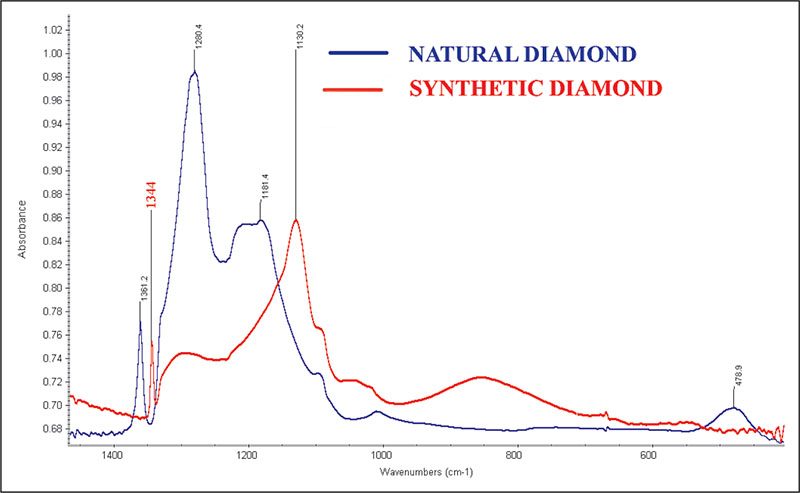
synthetic diamond has peaks at 1344 and 1107 cm-1 characteristic of isolated nitrogens.
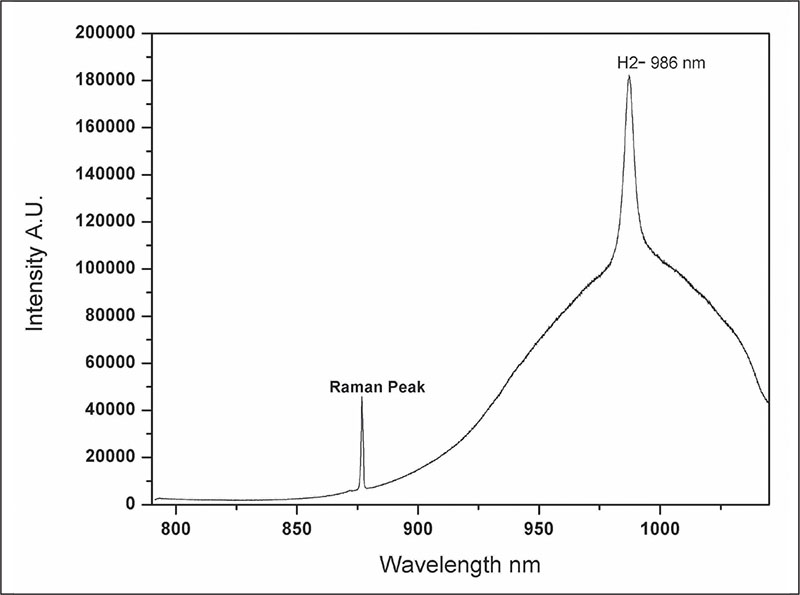
Strong signal due to H2 centre at 987nm can be seen.
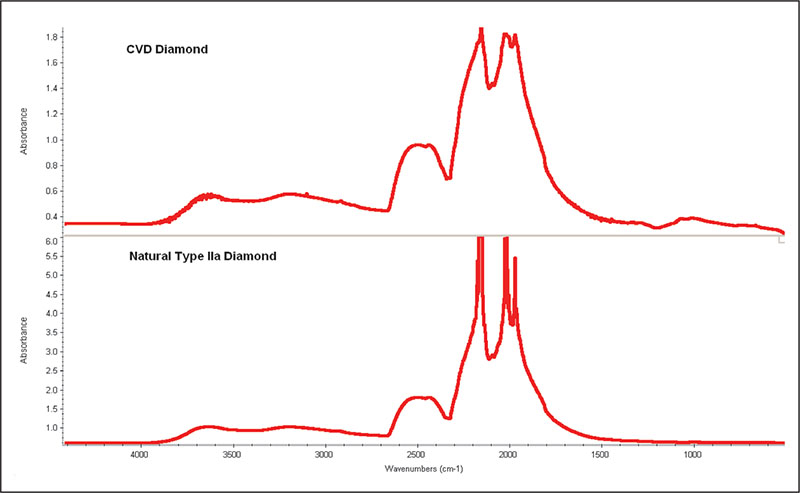
IIa (bottom) is included for comparison.
The R&D efforts at the Gemmological Institute of India (GII) resulted in the development of an instrument which meets this requirement with a high degree of satisfaction. In what follows these aspects will be presented briefly.
HPHT Synthetic Diamonds
Fourier Transform-Infrared (FTIR), Raman, Photoluminescence (PL) and UV-Visible absorption methods are conventionally used for diamond diagnostics. Figure 1 shows the spectral differences between natural diamond and HPHT synthetic diamonds. The HPHT synthetic diamond contains predominantly isolated nitrogens at carbon sites as impurities (type Ib diamond). The local mode of such a nitrogen site has absorption at 1130 cm-1 and it is distinctly different from that due to A and B aggregates of nitrogen that occur in natural diamonds. Figure 2 shows the 785 nm excited PL of HPHT synthetic diamond. The emission observed at 987 nm is due to the H2 centre, electron trapped N-V-N centre. Such centres are observed in natural crystals only after radiation and heat treatments, as grown HPHT synthetics do stabilise H2 centres.
CVD Diamonds
We have studied the spectral properties of a number of CVD-grown crystals obtained from different sources. While all the synthetic HPHT grown diamonds are of type Ib or IIb by addition of boron, quite often one can grow highly pure type IIa diamonds by the CVD route. Figure 3 shows the FT-IR spectra of a typical CVD-grown diamond. The spectrum of natural type IIa diamond is included for comparison. It can be seen that there are no absorption features in the nitrogen region (600-1400cm1) in both crystals.
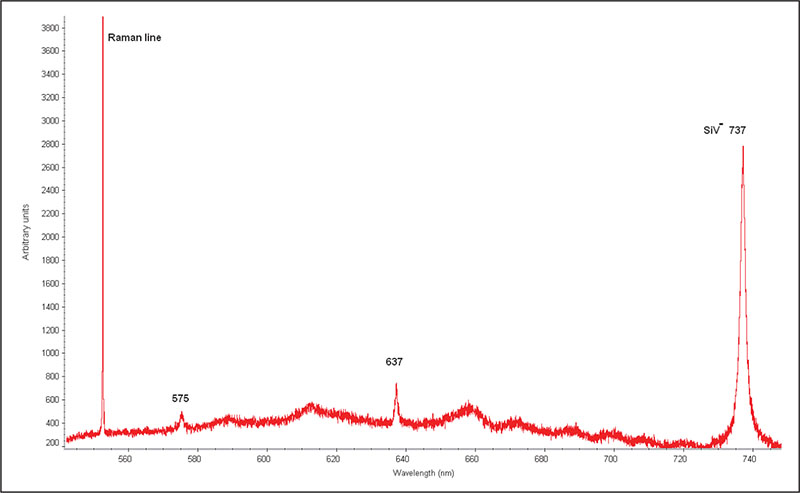
to SiV- at 737 nm can be seen. This is absent in most natural diamonds.
Compared to HPHT-grown diamonds, the detection of CVD diamonds poses more challenges. The point defects in CVD diamonds are different from those observed in HPHT diamonds. These are silicon-vacancy centres (SiV and SiV-) and hydrogen related centres such as N-V-H. Figure 4 shows the 514 nm excited PL of a CVD diamond and Figure 5 shows the 785 nm excited PL of the same diamond at 77K. The PL emission from SiV- at 737 nm and that due to SiV0 at 947 nm can be seen in Figures 4 and 5 respectively.
This work demonstrates the necessity of using all the spectroscopic techniques in tandem to get the complete information about the diamonds.
Luminescence Method
The luminescence properties of diamonds have proved to be invaluable in the detection of synthetic diamonds. It is known that all natural diamonds belonging to Ia (98% abundant) and IIa diamonds (nearly 2%) do not show phosphorescence. The exceptions are those belonging to IIb (abundance less than 0.1%). In the fluorescence mode all natural diamonds exhibit blue fluorescence (A-band). Among colourless to near colourless synthetics, most of HPHT synthetics exhibit phosphorescence; among CVDgrown synthetics some exhibit phosphorescence and most others show fluorescence in green/pink or yellow. Using the luminescence technique, we have developed an instrument for quickly screening diamond lots typically in 0.5 cents to a few cents, for the presence of synthetic diamonds.
A summary of the performance of the machine developed by GII is given below.


